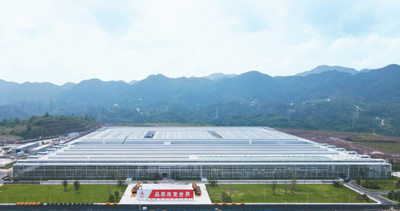China’s manufacturing sector gathers speed on road to digital transformation
China is accelerating its digital transformation to further upgrade the country’s manufacturing industry and rachet up its pursuit of high-quality development, with “lighthouse factories” that represent some of the most advanced manufacturing facilities in the world leading the way through their implementation of smart manufacturing.

Photo shows a smart factory operated by Sany Heavy Industry Co., Ltd. in Liangjiang New Area, southwest China’s Chongqing municipality. It’s the company’s first smart factory in southwest China. (Xinhua/Xu Qin)
Inside one such factory, automatic-guided vehicles move freely around on the ground floor while industrial robots featuring visual-sensing capabilities assemble together machinery parts on production lines at the Beijing Rotary Drilling Rig Plant operated by leading Chinese heavy-equipment manufacturer Sany Heavy Industry Co., Ltd. The factory has been added to the World Economic Forum’s Global Lighthouse Network, which recognizes those factories demonstrating leadership in applying Fourth Industrial Revolution (4IR) technologies.
Notably, the factory is the first heavy-industry enterprise globally to be added to the list. The factory began to leverage the power of industrial Internet technology in 2018. Now it is well-equipped with eight flexible work centers, 16 intelligent production lines and 375 production facilities connected to the Internet. Meanwhile, an industrial Internet platform deployed by the factory can collect data non-stop and provide optimal parameters for each production process.
The upgrades to the factory have served to provide an additional boost to its production efficiency and product quality. Moreover, the factory’s digital transformation has managed to increase the overall operation rate of its production equipment from 60 percent to about 90 percent in addition to slashing the production cycle by nearly 80 percent.
A microwave oven factory operated by Chinese home appliance giant Midea Group in Shunde district, Foshan city of south China’s Guangdong Province, is also a "lighthouse factory.” Similarly, the digitalization of the factory’s industrial chain has improved its overall internal efficiency by 28 percent and product quality indicators by 15 percent, while shortening order lead time by 56 percent.
Sheng Chaoxun, a researcher with the Chinese Academy of Macroeconomic Research, said that “lighthouse factories” adopt a series of 4IR technologies at scale – ranging from automation, industrial Internet, cloud computing, big data to 5G technologies.
Noting that the term “lighthouse factory” is a byword for technology-intensive manufacturing, innovation, high labor productivity, high economic returns and green development, Sheng said that these factories are leading the way in smart manufacturing and digital transformation.

Photo shows a smart factory in east China’s Zhejiang Province. (Xinhua/Xu Yu)
So far, 31 factories in China have joined the Lighthouse Network as leaders in applying 4IR technologies and represent the best examples of digital manufacturing and Industry 4.0, accounting for over one-third of the global total. Besides, leading manufacturing enterprises such as Sany and Midea Group are striving to build more and more “lighthouse factories.” Being able to provide digital solutions, these enterprises can also empower small- and medium-sized enterprises with digital technologies.
China is leading the world in some fields within the smart manufacturing industry. Located in Ningde city, southeast China’s Fujian Province, the Ningde factory of Contemporary Amperex Technology Co., Ltd. (CATL), China’s leading automotive lithium-ion battery maker, is the first battery factory globally that has been added to the Lighthouse Network.
Confronted with the increasing complexity of manufacturing processes and a rising demand for higher product quality, CATL has leveraged artificial intelligence, advanced analytics and edge/cloud computing to achieve, within only a short three-year period, a defect rate per billion count at the speed of 1.7s per cell, while improving labor productivity by 75 percent and reducing energy consumption by 10 percent a year.
According to industry insiders, more and more “lighthouse factories” will help accelerate the transformation from “made in China” to “intelligently manufactured in China” and boost the digital transformation and high-quality development of the country’s manufacturing sector.
“After years of development, China's smart manufacturing has entered a period of accelerated development,” Sheng said.
China has made significant progress in making the country’s manufacturing sector more digitalized, networked and intelligent since 2016. Data from the Ministry of Industry and Information Technology (MIIT) showed that intelligent manufacturing facilities are able to meet over 50 percent of domestic demand. The country has also released 285 national standards and led the formulation of 28 separate international standards in this regard. China has also cultivated over 70 influential industrial internet platforms.
According to a development plan for smart manufacturing during the 14th Five-Year period (2021-2025) issued by the MIIT and other departments, China plans to build industry-leading smart-manufacturing demonstration plants.
Various localities in China have also accelerated the pace for boosting smart manufacturing. For example, Shanghai aims to cultivate 100 smart manufacturing factories, including 10 benchmark factories, develop 10 industry-leading system integrators for smart manufacturing, and build 10 industrial Internet platforms in vertical industries by 2022.


